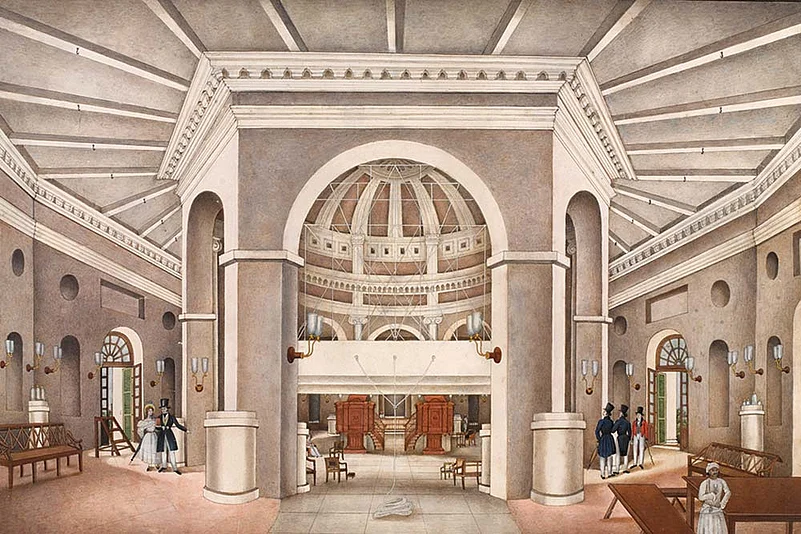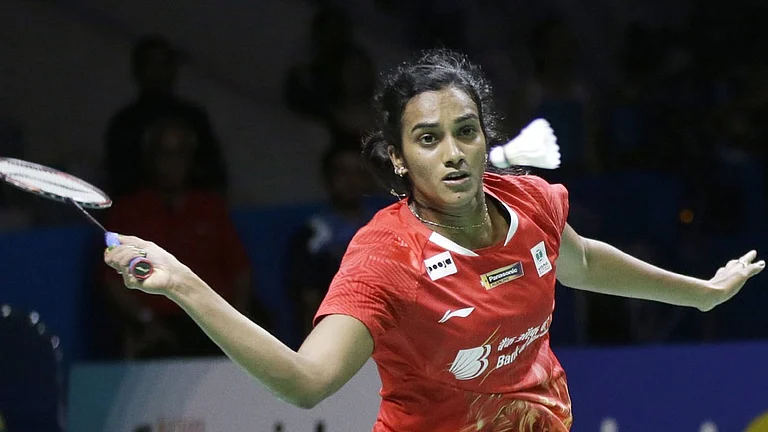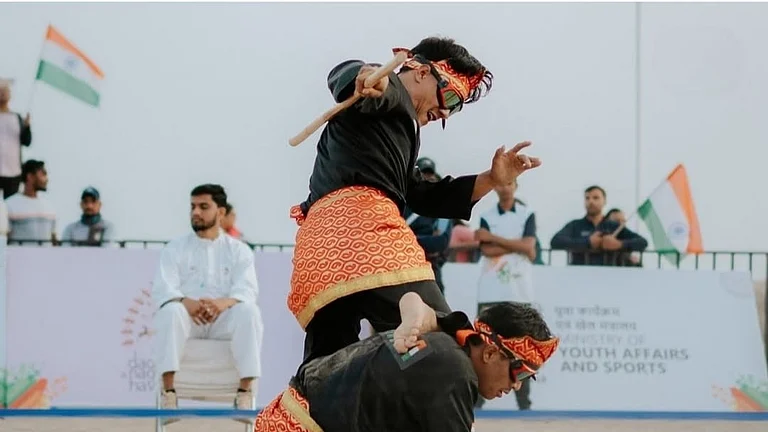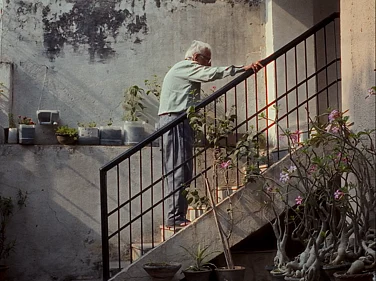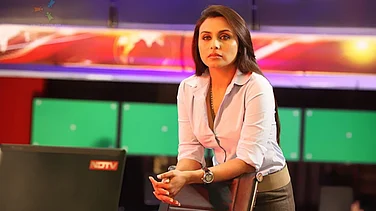In the late eighteenth century, Lucknow was at the height of its Golden Age. Mughal Delhi, its nearest rival, had been looted and burned by successive waves of invaders and now lay wrecked and ruined. Delhi’s artists and poets and painters had little option but to flee to the flamboyant, newly rich city to the east.
There they sought the patronage of a dynasty of nawabs who had the means to patronise artists with a generosity that soon became legendary. Lucknow’s singers and Kathak dancers were admired as the most gorgeously accomplished; its cuisine and architecture celebrated as the most flamboyantly baroque; its poets much celebrated, if a little gushy, for the more austere taste of Ghalib in Delhi.
At the artistic and financial centre of this world lay Claude Martin, the enigmatic self-made French buccaneer-businessman from Lyon, who went on to leave a legacy for the three schools—in Lucknow, Calcutta and Lyons—which still bear his name. Martin combined the lifestyle of a Mughal prince with the interests of an Enlightenment aesthete: he maintained an astronomical observatory, experimented with map making, air pumps and botany, hot air balloons and even bladder surgery. He also built a palace-mausoleum, named Constantia, where Palladian arcades rise to Mughal copulas. Here, Martin made one of the most influential commissions of his age.
Sometime in the 1770s, Claude Martin imported no less than 17,000 sheets of European watercolour paper and employed a team of Lucknavi master artists to paint a series of natural history pictures. The artists had clearly trained in the Mughal style and used Mughal stone-based pigments, but working on European paper and having been shown as models European natural history images—probably the Comte de Buffon’s Histoire Naturelle des Oiseux—they gave birth to a new hybrid style, one that was unquestionably Lucknawi-Mughal, but with a strong European influence.

Asian Openbill Stork, Lucknow, c.1780, unknown artist.
One of the masterpieces produced at this time is a portrait of an Adjutant Stork, now in a private collection. The bird is placed in profile against a white background; at the bottom of the frame there is a distant panorama of trees and bushes stretching out through the flat Gangetic plains—a miniaturised landscape of tiny rivers and trees, as if the plains around Lucknow had become a South Asian Lilliput. It may well have been Claude Martin who, for the first time, encouraged Mughal artists to use all their artistic sensibilities and training while also consciously studying European models, to produce something that is not just a neutral scientific natural history study, but an art work in its own right, so bringing together European and Mughal aesthetics to produce something that was both utterly new and ravishingly beautiful. Two traditions meet head on, and from that impact an inspirational fusion has taken place, a hybrid style that brings out of the best qualities of both traditions.
Soon the fashion caught on: “the Study of Botany is of late Years become a very general Amusement,” noted one enthusiast, and we know that the Scottish nurseryman James Kerr was sending Indian-painted botanical drawings back to Edinburgh as early as 1773. At some stage in the mid to late-1770s, Sir Elijah Impey and his wife Mary decided to bring a group of leading Mughal artists down from Patna—Sheikh Zain ud-Din, Bhawani Das and Ram Das—to paint their private zoo. The Impeys’ albums remain among the most dazzlingly successful of all such commissions: today a single page usually reaches prices of more than a third of a million sterling at auctions, and the 197 images from the Impey Album are now widely recognised as among the very greatest glories of Indian painting.

Six Recruits, by the Family of Ghulam Ali Khan, from the Fraser Album, c.1810.
There was also a growing appreciation of the skills of Indian artists: in 1790 William Tenant praised Indian botanical artists, particularly, “the laborious exactness with which they imitate…the smallest fibre on the leaf of a plant”. His words were echoed by Maria Graham a few years later: “They are the most beautiful and correct delineations of flowers I ever saw. Indeed, the Hindoos excel in this kind of work.”
Suddenly, every Company officer was commissioning Indian artists to paint not just the natural history and botany and landscapes, but also architecture and everyday life: curiosities and processions, festivals and ceremonies, modes of transport and hierarchies of domestic servants, stables of horses and troupes of dancers, crafts and trades, castes and types, and what ordinary people wore. Many of these were subjects which India’s princely patrons had ignored, with their concentration on images of rulers, durbars and deities. This was a “clear departure from Mughal usage”, wrote Mildred Archer. “Indian-British painting frankly accepted villagers, workers and servants, village ceremonies and rituals, as proper subjects for art…. It democratised Indian painting.”
***
Forgotten Masters: Indian Painting for the East India Company, which opens at the Wallace Collection in London on December 4, sponsored by DAG and several other generous Indian patrons, celebrates some of the many masterpieces that resulted from commissions made by East India Company patrons from Indian artists between the late-18th and mid-19th centuries, roughly between 1770s and 1840s. These art works, often of astonishing brilliance, and possessing a startlingly hybrid originality, represent the last phase of Indian artistic genius before the onset of the twin assaults—photography and the influence of western colonial art schools—ended a tradition of painting going back two thousand years.
The artists who produced these works were drawn from a wide variety of Indian artistic traditions—Mughal, Maratha, Tamil and Telegu—an equally wide range of castes and communities ranging from titled imperial office holders like the grand Mughal artist Ghulam Ali Khan, to much more humble artists who described themselves as moochies and who seem originally to have been leather workers. Some appear to have been kalamkari textile painters before being recruited by Company botanists, others from the gudyar sandal wood carver caste.

Cycad by Chunnilal, commissioned by Adam Freer.
Since art historian Mildred Archer began writing on the subject in the 1950s, these paintings have been known as ‘Company School’, an English translation of an Urdu term which she found being used for such works in Patna—‘Kampani qalam’. The term is useful and is probably unavoidable, but it is also problematic, for it emphasises colonial patronage of these works over the artistic endeavours of the brilliant Indian artists who actually painted the works; and it has led to the genre being left in something of a post-colonial limbo, largely disowned by Indians and forgotten and ignored by the descendants of their former colonial masters. When B.N. Goswamy chose 101 of his favourite Indian pictures, only one, the very last, was a company commission, and Company painting forms only a brief and sketchy adjunct at the end of Goswamy’s massive two-volume catalogue raisonné, Masters of Indian Painting.
As the brilliant art works in Forgotten Masters demonstrate, the diverse works that have come to be grouped as “Company School paintings” include some of the greatest masterworks of all Indian art, and the prices now paid in salesrooms for the best examples make leaves of the Fraser and Impey Albums, or those of Claude Martin’s Lucknow Menagerie, some of the most expensive and desirable on the market. But while there have been several shows of Company Painting in India and the US, including one at the CSMVS in Mumbai last November, there has never before been a museum show of Company-commissioned Indian art in Britain, despite this country possessing unrivalled masterpieces in both museums and private collections. The reason for this is not aesthetic so much as political.
Throughout the 1950s and 1960s, in the humiliation of the British retreat from empire, art associated with Raj came to be regarded in Britain with a deep ambivalence. Most were simply taken off the walls and sent into storage. A few were packed off to languish in the provinces: The Remnants of an Army, Lady Butler’s famous image of Dr Brydon—the sole survivor of the disastrous 1842 retreat from Kabul—one of the most iconic paintings of the empire, was quietly removed from the walls and sent to languish in a regimental museum in Somerset. Today it is almost impossible to find any major gallery within Britain that still puts on show a significant collection of art connected in any way with the Raj. Disowned by subsequent history, the Indian art commissioned by the Company has effectively been orphaned and ignored, both in India and the West.
But once ‘Company Painting’ comes to be understood to be the result of a fruitfully catalytic act of patronage of great Indian artists by admiring British patrons, it becomes possible to appreciate these unusually beautiful paintings as an Indian art—indeed one of the most interesting and fecund phases of Indian painting. Caught in the cross-winds of East and West, these forgotten masterpieces were merely the last phase of India’s artistic interaction with the wider world.
Now, perhaps for the first time, the work of artists painting in this brilliantly hybrid style is now beginning to get the attention they deserve. Forgotten Masterpieces aims to highlight and showcase the work of a series of extraordinary Indian artists, each with their own style and tastes and agency, the greatest of whom deserve to be remembered as among the most remarkable Indian artists of all time.
(Forgotten Masters: Indian Painting for the East India Company opens at the Wallace Collection on the 4th December. The exhibition catalogue, edited by William Dalrymple, is published by Bloomsbury)






